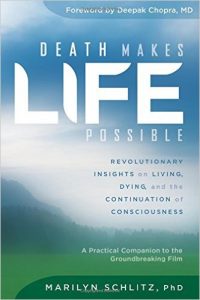 Death Makes Life Possible: Revolutionary Insights on Living, Dying, and the Continuation of Consciousness by Marilyn Schlitz
Death Makes Life Possible: Revolutionary Insights on Living, Dying, and the Continuation of Consciousness by Marilyn Schlitz
Reviewed by David Lorimer
If this review were charades, I would indicate that it is both a book and a documentary film, which brings some of its central themes alive with interviews from a wide range of disciplines and viewpoints. The title came from Deepak Chopra, who contributes the foreword. As it happens, I am writing this review in front of a fire at Cawdor Castle where one of the participants in the seminar used as a point of departure the masterpiece by Gauguin entitled ‘Where do we come from, Who are we and where are we going’ (no question marks..). This insightful book grapples with these central existential questions, and especially with the nature of transformation. Impermanence implies constant change, the death of the old and the birth of the new, which is going on in our bodies all the time. Deepak asserts that nothing is created or destroyed, only transformed – why should this not apply to human life as well? Each new form is another potential to be unfolded and fulfilled as a unique expression of life.
Marilyn tackles the topic of death at a fundamental level, situating her discussion in the context of the tension between materialist and post-materialist theories of mind and consciousness. The vast majority of scientists still seem to believe that consciousness is produced by the brain and is extinguished at death. As this book makes clear, there is a large body of evidence suggesting that consciousness continues in some form after the death of the physical body so we have the emergence at the intersection between science and religion of a new evidence-based spirituality that has been a central concern of the Network since its inception over 40 years ago and the publication of Raymond Moody’s Life after Life in 1975.
The many interviews bring a great deal of wisdom and insight to bear on the various aspects of death discussed. A centrepiece of the film is the death of Lee Lipsenthal at the age of 53. He shows great courage in the face of his terminal illness as he gradually loses control of his bodily functions and is filled with gratitude for the life and love he has experienced. We frequently transform only in response to crisis, as a number of case histories show, but we do not need to wait for a crisis to begin our preparations for our eventual departure, as Marilyn shows. Spiritual practices are important and can help shift our perspective from the independent me to the interdependent we so that we can live more deeply and fully, playing our part in a collective transformation.
This can lead to a widening of our identity beyond familiar roles, as Satish Kumar points out. Although our small identity does not survive death, we are all expressions of something larger, of life itself. Out of fear and ignorance the ego grasps and clings, while we are called upon to expand, let go and transform: ‘Life never ends. It’s only the form that changes.’ Many writers also point out the relationship between fear of death and fear of really living and fully expressing beauty, intelligence, love and joy. We can also ask ourselves the four questions of Lauren Artress: ‘are you deepening your compassion? Are you learning to be less judgmental? Are you learning to be more patient? And is there a way you are finding to be of service in the world?’ If we imagine ourselves on our deathbeds we can more easily distinguish the essential from the inessential and live in the present so as to have fewer regrets when the time comes.
The overall impact of this informative and wise book is to deepen the reader’s engagement not only with death but also with life as it is lived in the present from moment to moment. Too many of us postpone or avoid facing death until the last moment and try to shelter our families from it. Then we can take life for granted, busying ourselves with immediate concerns with no consideration of the deeper picture as revealed not only by cutting-edge science but with our unprecedented access to the world’s spiritual traditions. As Marilyn puts it, we can all become more awake, willing and engaged (AWE) and help form a new model for living and dying as part of our collective metamorphosis.
